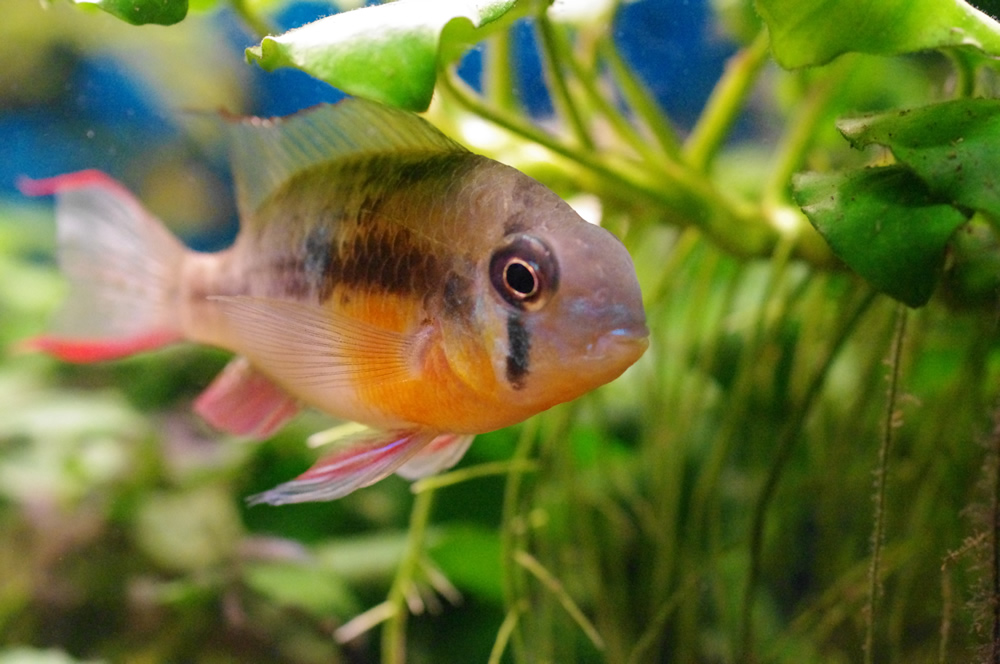Who are Mikrogeophagus ?
In 2020, the
Mikrogeophagus genus includes only two different species:
M. altispinosus and
M. ramirezi. These two dwarf species are found in South American freshwaters.
Mikrogeophagus is one of the most controversial genus among American freshwater fishes. At least thirty years were needed before the genus has officially been recognised. To this day, both species are sometimes still called differently:
Apistogramma can be used for the ramirezi (or ram cichlid),
Crenicara for the altispinosus, and finally
Microgeophagus or
Papiliochromis for both of them.
The first reference to a species of this genus dates back to 1948, when an article written by William T. Innes regarding ornamental fishes, had been published in a specialised magazine. The species
Mikrogeophagus ramirezi was described as an
Apistogramma ramirezi fish by George S. Myers and Robert R. Harry.
Although its morphology is different from the
Apistogramma one, the ram cichlid (
M. ramirezi) has been classified in the
Apistogramma genus for years. The
Microgeophagus name has been used in 1957 for the first time, in a book about aquarium fishes. But it's only in 1971, following an article written by fish expert Axelrod, that the
Microgeophagus genus name stood out. At this time, some voices raised for a new description of the ram cichlid among the
Geophagus genus, a close genus composed of South American soil-eating cichlids.
In the 1970s, both species of the genus were frequently mixed up. Ram cichlids imported from Bolivia actually were altispinosus fishes. Then in 1977, Kullander described the
Papiliochromis genus using a ram cichlid as a standard species. This new name was largely adopted, but in the 1980s, several renowned scientists stated that the genus name
Microgeophagus, at this time spelled
Mikrogeophagus, prevailed over
Papiliochromis, because it was used before to describe both species.
What are the differences between Mikrogeophagus and Apistogramma fishes ?
Mikrogeophagus and
Apistogramma fishes are very different in their morphology and their behaviour, including reproduction.
Dimorphism is less significant for
Mikrogeophagus. Females are slightly smaller, but their colours are very similar to male ones. In the
Apistogramma genus, males are significantly bigger and have more elongated fins. In addition, males and females have often very different colours. The
Mikrogeophagus female has a small lateral spot on its body, which the
Apistogramma female does not have.
Regarding reproduction,
Mikrogeophagus fishes are exclusively monogamous, whereas several
Apistogramma species are polygamous. In the
Mikrogeophagus genus, both parents nurture their offsprings and egg-laying occurs on horizontal areas or in pits. On the other side,
Apistogramma fishes lay their eggs most of the time on wooden or vertical areas. The female alone takes care of the eggs, while the male is defending the territory.
Apparently, the ram cichlid was initially classified in the
Apistogramma genus because of its small size and the presence of an epibranchial lobe, even though this lobe is much bigger for other
Mikrogeophagus fishes.
Actually,
Mikrogeophagus fishes are closer to big soil-eating species of the
Acarichthys,
Biotodoma,
Geophagus,
Gymnogeophagus and
Retroculus genera than to
Apistogramma fishes.
En attente de chargement...
